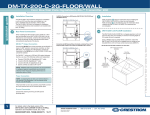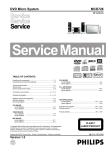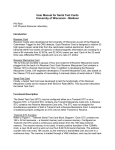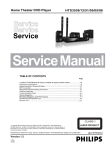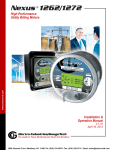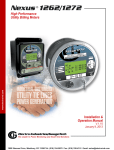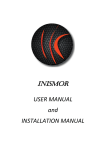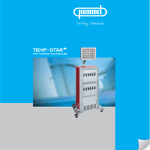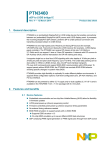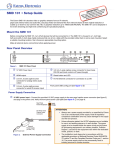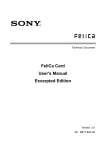Download Integrated Device Technology DDR II Register
Transcript
User Manual – DDR II Register Validation Board Integrated Device Technology DDR II Register Validation Board User Manual Document Name: DDR II Register Validation Board User Manual Prepared by: Chris Macaraeg Revision: 0.7 Date: September 6, 2003 Copyright © Integrated Device Technology Inc. Copyright © Integrated Device Technology Inc. (IDT). All rights reserved. This document contains information that is proprietary to IDT Inc. Use, transfer, or other duplication without the expressed written consent of IDT, Inc. is strictly prohibited. 9/6/2003 1 of 30 User Manual – DDR II Register Validation Board ,QWURGXFWLRQ The DDR II Register Validation Board is a standalone test fixture that was designed to provide testing and validation for the DDRII SSTU32864 register in an environment that simulates actual usage. It requires no additional equipment except a PC-ATX power supply, and a high-speed oscilloscope. The devices to be tested must be mounted on a DIMM or other DIMM socket compatible test board. The board will accept functional DIMMs, or DIMMs that have been modified especially for designated tests. While it is not the goal of the test fixture to test unbuffered DIMMs, these devices can also be plugged into the test socket. It is also not the goal to test PLL operation on the board, but all clocks are provided to the DIMM, along with spread spectrum capability if the user wishes to examine those areas. 9/6/2003 2 of 30 User Manual – DDR II Register Validation Board 6\VWHP)HDWXUHV The register validation board was designed to drive a DDRII DIMM in a standard DDRII DIMM socket. The intended purpose of the board is testing of the SSTU32864 registers on the DIMM. The test capabilities include the following: 1. Provision for virtually any addressing pattern. Up to 256 patterns can be implemented, with 512 vectors per pattern. 2. Setup and hold time testing of the DIMM register. The address sent to the DIMM can be skewed relative to the clock in 10ps increments, allowing the user to determine the exact point of DIMM failure due to setup/hold time violations. 3. CKE, ODT, and CS operation relative to clock. These signals are skewed independently of the clock and address to allow testing of setup/hold time. 4. Reset recovery. A test vector controls the reset input to the DIMM; it can be toggled in the midst of a pattern to determine the time required to complete a reset. 5. Corner voltage testing on the DIMM VDD voltage pins. VDD on the DIMM can be set to any point between 1.7V and 1.9V. 6. Corner voltage testing on the DIMM VREF pin. VREF on the DIMM can be set to any point between 800mV and 1.07V 7. Provision for driving the board clocks with an external signal source. 8. Capability to enable or disable Spread Spectrum Clocking (SSC) modulation if the on-board clock source is used. 9. Up to 266MHz operation. 10. Simultaneous switching delay testing. 11. Noise and signal integrity testing. 9/6/2003 3 of 30 User Manual – DDR II Register Validation Board &RQILJXUDEOH)XQFWLRQV Before testing begins, the user must configure the board properly. All of the functions on the board that must be configured, and the default settings that the board is shipped with are listed in Table 1. PCB Label Adjustment 1 Location Values CDC960_SPREAD S5-7 0 = disabled 1 = enabled 1 MREFSEL S5-3 0 = CDC960 1 = External Source 0 CDC960_FS[2:0] S5- [6-4] 101b = 133MHz 100b = 100 MHz 101b DIMM Control 5 Register Delay CTL_DLY[10:0] S5- [2:0], S4- [7:0] DIMM Address 6 Register Delay ADDR_DLY[10:0] S7- [2:0], S6- [7:0] W1 W1 PATTERN[7:0] S3- [7:0] Function Spread Spectrum Clocking Enable Clock Source Select CDC960 Frequency 4 Select FLASH/PROM Select Test Pattern Select DIMM VREF Adjustment DIMM VDD Adjustment DIMM 900mV ADJUST DIMM 1.8V ADJUST R23 R1 Default 3 setting 2 0000000000b = min delay 1xxxxxxxxxb = max delay 0000000000b = min delay 1xxxxxxxxxb = max delay A-B = PROM B-C = FLASH See Table 4 00010000000b 00010000000b A-B 00000000b 800mV to 1.07V (potentiometer) 1.7V to 1.9V (potentiometer) 900mV 1.8V Table 1: User Configurable Functions and Default Values 1 If multiple switches are listed the first is the MSB, the last is the LSB. “1” = switch open, “0” = switch close. 3 “1” = switch open, “0” = switch close. 4 Switch settings not listed in the table are not supported. The DIMM clock frequencies are double the CDC960 clock frequency. 5 Minimum delay is nominally 2.2ps; additional delay is approximately 10ps per step. Refer to On Semicconductor MC100EP195 data sheet. 6 Minimum delay is nominally 2.2ps; additional delay is approximately 10ps per step. Refer to On Semicconductor MC100EP195 data sheet. 2 9/6/2003 4 of 30 User Manual – DDR II Register Validation Board &RQILJXUDEOH)XQFWLRQ'HWDLOV This section contains a detailed discussion of the configurable functions. 6SUHDG6SHFWUXP&ORFNLQJ The DDR II Validation Board contains a Texas Instruments CDC960 Clock Synthesizer/Driver that is used to provide an on-board clock source to the circuitry. This device includes Spread Spectrum Clocking (SSC) with a 0.5% downspread for reduced EMI. The IDT 5T2110 Differential Clock Driver will pass on the CDC960’s SSC modulation to the registers under test on the DIMM. This board has the capability to enable or disable SSC modulation on the CDC960. 6HOHFWDEOH&ORFN6RXUFH There may be occasions where the user would like to drive the board’s clocks with a frequency that is not supported by the CDC960. In this case, differential SMA connectors are provided for the user to connect an external differential clock source. This board has the capability to select between the CDC960’s differential clock outputs, and the external clock source through the SMA connectors. If an external clock source is used, it’s frequency must not exceed 135MHz, nor be less than 50MHz. If it does, board operation is not guaranteed. In addition, if SSC modulation is desired, the external clock source must provide it. &'&)UHTXHQF\6HOHFW The TI CDC960 has the capability to provide multiple frequencies to the board. Currently, however, only the 100MHz and 133MHz frequencies are supported. These clocks are doubled in frequency by the IDT 5T2110 devices, so the DIMM clocks will actually be 200MHz or 266MHz. ',00&RQWURODQG'DWD5HJLVWHU'HOD\ Test patterns drive the DIMM control and address lines through separate Control and Data registers, as shown in Table 3. The two registers are driven by separate clocks that can be individually delayed in time by 2.2ns to 12.2ns relative to the DIMM clocks. By adjusting either the control register clock, the data register clock, or both simultaneously, the user could: 9/6/2003 5 of 30 User Manual – DDR II Register Validation Board • Test setup and hold times of the address and control relative to the DIMM clock, • Test setup and hold times of the address only, while keeping the control bits within spec, or • Test setup and hold times of the control bits only, while keeping the address bits within spec. )/$6+RU3520VHOHFW The DDR II Register Validation Board is designed to accept either 4Mbit FLASH or PROM as the nonvolatile storage device for the test patterns. However, one pin is defined differently between the FLASH and PROM. A jumper is provided to select the correct pin configuration. This function will be set at the factory and is dependent upon which device the board is populated with. This function never needs to be changed by the user. 7HVW3DWWHUQ6HOHFW Up to 256 test patterns can be supported by the DDR II Register Validation Board. The test pattern is selected by configuring the proper switches. See Section 11 for more details. ',0095()$GMXVWPHQW This board has the capability to adjust the VREF input to the DIMM. This will not affect the VREF inputs on any device on the DDR II Register Validation Board; it only affects the VREF pin on the DIMM. To adjust VREF to the DIMM, the board must be powered on, the potentiometer at location R52 adjusted, and the voltage checked with a DVM. ',009''$GMXVWPHQW This board has the capability to adjust the VDD power supply input to the DIMM. This will not affect the power inputs to any device on the DDR II Register Validation Board; it only affects the VDD pins on the DIMM. To adjust VDD to the DIMM, the board must be powered on, the potentiometer at location R53 adjusted, and the voltage checked with a DVM. 9/6/2003 6 of 30 User Manual – DDR II Register Validation Board 5HTXLUHG(TXLSPHQW The equipment required to operate the DDR II Register Validation Board consists of just a PC-ATX power supply, and a high-speed oscilloscope. The power requirements on the board are minimal. The lowest-powered supply available today provides approximately 230W, and this is sufficient. The recommended oscilloscope and probe requirements are listed in Table 2. (NOTE: THESE REQUIREMENTS WERE TAKEN FROM THE OLD BOARD MANUAL, AND MAY HAVE TO CHANGE TO INCLUDE A HIGHER SPEED OSCILLOSCOPE, OR EQUIPMENT THAT CAN MEASURE SPREAD SPECTRUM) Recommended Oscilloscope Characteristics Sampling Rate (Real Time) Minimum of 4G samples/second RMS Jitter < 6ps +/- 0.005% of delay setting Recommended Probe Characteristics Rise Time <140ps Bandwidth (3dB) > 2.5GHz Input Resistance 100kOhm Input Capacitance 0.6pF Table 2: Recommended Oscilloscope and Probe Characteristics 3UREH&DOLEUDWLRQ T.B.D. 9/6/2003 7 of 30 User Manual – DDR II Register Validation Board %RDUG6HWXS Install the DIMM in the test socket; insert the ATX power supply connector into the appropriate connector on the board. The DIMM must be installed or removed from its test socket only when the power is off. After the DIMM and power supply are installed, flipping S2 switch to the “on” position will turn on the board power. 9/6/2003 8 of 30 User Manual – DDR II Register Validation Board %RDUG,QLWLDOL]DWLRQ With the board powered on, select the Initialization Pattern (see Table 1 and Table 4), and then depress the Master Reset switch. This will initialize the SDRAMs on the DDR II DIMM (if they are installed) and place the board in a state where it is ready to be used. The initialization step must be executed after the power is turned on. If the power to the board is cycled, the initialization step must be rerun. If the Synchronization Pattern is run (see Section 7.2), then the initialization step must be run again afterwards. 9/6/2003 9 of 30 User Manual – DDR II Register Validation Board &RQILJXULQJWKH9DOLGDWLRQ%RDUGIRU7HVW Before testing can begin, the delay lines and variable voltages on the board must be set up. 6HWWLQJ8SWKH9DULDEOH9ROWDJHV On the DDR II Register Validation Board, the DIMM VDD and VREF voltages are adjustable. The user will determine what level to set these voltages to. The ranges for these voltages are listed in Table 1. 6HWWLQJ8SWKH'HOD\/LQHV The delay lines must also be configured such that the address and control presented to the SSTU32864 registers on the DIMM meet the specified setup and hold times (see the appropriate data sheet for the timing specifications). A test pattern has been implemented to assist in setting up the delay lines. This is the Synchronization Pattern (see Table 4). This pattern will pulse the data and control bits simultaneously every 32 clock cycles. This will assist in not only aligning the control and data register outputs with the clock, but also aligning the two registers with each other. To configure the Data Register delay line so that the data signals meet the setup and hold times, the user must simultaneously probe the clock pin and one of the data pins on the SSTU32864. If the timing is not as desired, then the DIMM Data Register Delay must be changed to suit by modifying the appropriate switches (see Table 1). After the timing has been adjusted and verified, the remaining data bits can be checked – the bit-to-bit skew for the data signals will be approximately 10ps maximum. 9/6/2003 10 of 30 User Manual – DDR II Register Validation Board After this process is completed for the Data Register, the same process must be executed to set up the Control Register delay line. Once the Data Register and Control Register delay lines are set up, it is recommended that the switch settings be recorded so they can be used as a baseline setting for future tests. The steps for configuring the registers are listed below. 1. Install the DIMM and power supply as described in Section 5. Turn the power on. 2. Set the appropriate switches to select the Synchronization Pattern (see Table 1 and Table 4). When configuring the delay lines after power up, it is not necessary to run the Initialization Pattern. 3. Depress the Master Switch button to load and run the Synchronization Pattern. 4. Set up the oscilloscope to probe an appropriate data bit and clock on the DIMM. If the timing is not correct, adjust S6 and S7 until the desired timing is attained. 5. Set up the oscilloscope to probe an appropriate control bit and clock on the DIMM. If the timing is not correct, adjust S4 and S5 until the desired timing is attained. Normally, the control and data bits would be aligned, but this is entirely up to the user. 6. Rerun the Initialization Pattern to place the SDRAMs in a known state (see Section 6). The board is now ready to be used. 9/6/2003 11 of 30 User Manual – DDR II Register Validation Board 5XQQLQJD7HVW After setting up the board (Section 5), initializing it (Section 6), and configuring it (Section 7), testing can begin. Testing the board consists of two parts – selecting the Test Pattern, and adjusting the register delay lines and checking the results. 6HOHFWLQJWKH7HVW3DWWHUQ To select the Test Pattern, set S3 to the proper value for the desired Test Pattern (see Table 1 and Table 4). Then, depress the Master Reset button. $GMXVWLQJWKH5HJLVWHU'HOD\/LQHVDQG&KHFNLQJWKH5HVXOWV The recommended procedure for this operation is as follows: 1. Connect the oscilloscope to the clock, at least one register input bit, and the corresponding register output bit(s). The only way to verify test results with the DDR II Register Validation Board is visually. 2. Check on the oscilloscope that the register input waveform looks similar to the register output waveform, but delayed by one clock cycle. If this is not the case, then the delay lines were not configured properly, and a timing parameter is being violated. The delay lines should be reconfigured (see Section 7.2). 3. If the input and output waveforms do look similar, then adjust the delay line timing, moving the input waveform in the direction that would test the desired timing parameter. 4. After each delay line adjustment, the register output should be checked on the oscilloscope, and the timing parameter being validated (for example setup or hold time) should be recorded. 5. When the register output no longer matches the register input waveforms (ignoring the one clock cycle skew), a failure has occurred and the timing specification limit has been reached. The last recorded timing parameter is the limit of the device. If the register output still matches the register input waveforms, then no failure has occurred. Step 3 must be repeated until a failure occurs. 9/6/2003 12 of 30 User Manual – DDR II Register Validation Board If a fine timing resolution is required, it could take a long time to step through enough delays to find where the device fails (since the delay increments would be small). To save time, it is recommended that the delay line adjustment start out as a relatively large delay (for example 160ps) until a failure occurs. When a failure is found, the delay can be set back to the last known good delay, and Step 3 above repeated using smaller increments (for example 10ps or 20ps). The amount of the increment depends upon the desired timing resolution. If 100ps resolution is required, then an increment of 40ps will probably suffice. If 50ps or finer resolution is required, then an increment of 20ps or 10ps could be used. Keep in mind that the minimum “step” of the delay line is equivalent to approximately 10ps. Also, the delay line has an overall delay of approximately 2.2ns to 12.2ns, so it is very easy to delay a signal multiple clock cycles with the delay line. Also, when adjusting the switch settings and multiple switches have to be flipped to obtain the proper increment, always change the MSB switch bit last. If the MSB bit is not switched last, a false error may occur due to the switches being momentarily set to a longer delay. 9/6/2003 13 of 30 User Manual – DDR II Register Validation Board 7KHRU\RI2SHUDWLRQ A Master Reset pulse will initiate the driving of test patterns onto the DDR II DIMM. A Master Reset pulse can be created in two ways: either by powering on the board, or by depressing the START BUTTON. For the following discussions, refer to the Block Diagram in 1. Note that all signal names used in this document refer to the board schematics, and not necessarily the block diagram. 9/6/2003 14 of 30 User Manual – DDR II Register Validation Board PLL/REGISTER VALIDATION DIFF LVTTL BOARD TI CDC960 CLK SYNTH DIFFERENTIAL SMA INPUTS 133MHz Rev 11 IDT 5T2110 PLL CLK DRVR eHSTL 133MHz DIPSW ON SEMI MC100EP195 PROG DL LVEPECL 133MHz HSTL, 133MHz HSTL, 133MHz HSTL, 133MHz A ALTERA 7256B EPLD CTL IDT 5T2110 PLL CLK DRVR CTL WC RC IDT D DDR/SDR FIFO (DATA) Q DIPSW HSTL SSTL, 266MHz SSTL, 266MHz SSTL, 266MHz SSTL, 266MHz RC WC IDT DDR/SDR D FIFO (CONTROL) Q IDT 5T2110 PLL CLK DRVR D HSTL, 266MHz HSTL, 266MHz Vref1 = 1.08V HSTL, 133MHz HSTL, 133MHz IDT 5T2110 PLL CLK DRVR HSTL Vref2 Vref2 SSTU32864 Vref3 (Adj.) DIPSW AT27040 PROM Vref1 = 1.08V 1.7V-1.9V Adjust. VDD eHSTL 133MHz ON SEMI MC100EP195 PROG DL LVEPECL 133MHz START BUTTON eHSTL 133MHz DCS, DCKE, DODT, RST# SSTL SSTU32864 RAS#, CAS#, WE#, ADDR SSTL 900mV = VTT2 LOAD DIFF SSTL, 266MHz DDR II DIMM SOCKET Figure 1: Board Block Diagram 9/6/2003 15 of 30 User Manual – DDR II Register Validation Board When a Master Reset pulse occurs, the EPLD will pass the configuration on the 8-position DIP-switch onto the upper 8 bits of the PROM address bus to “select” a pattern stored in the PROM. The value of the 8-position DIP-switch is meant to be static while a test is being conducted. If the configuration of the DIP-switch is modified, the Start Button must be depressed again to load the new pattern and begin a new test. A Pattern Word will then be read out of the PROM. A Pattern Word is defined as all the test bits that will be output to the DIMM’s I/O pins during a given clock cycle. Each test pattern consists of 512 Pattern Words. Since the Pattern Word is 32-bits wide, and the PROM is only 8-bits wide, the Pattern Word will be read out of the PROM 8 bits at a time. 9/6/2003 16 of 30 User Manual – DDR II Register Validation Board For a mapping of the Pattern Word contents to the DDR II DIMM I/O pins, refer to Section 9.1 When an entire 32-bit Pattern Word has been read out of the PROM and buffered in the EPLD, it will be written into the Data and Control FIFOs, and the next Pattern word will be read from the PROM. This process will continue until the 512 Pattern Words have been stored in the FIFOs. After the entire test pattern has been written into the FIFOs, a state machine within the EPLD will then place the FIFOs in the test mode, where the FIFOs are continuously read. The 512-word test pattern is repeated continuously by use of the MARK and RETRANSMIT pins of the FIFOs. For information on the test patterns, refer to Section 11. The test will be continuously run (driving the same pattern onto the DIMM pins continuously) until the START BUTTON is depressed again. 0DSSLQJRI),)2,QSXWWR',00,QSXW The field defined as CFIFO_DIN in the Pattern Word drives the input of the Control FIFO, and the fields defined as DFIFO_DIN in the Pattern Word drive the input of the Data FIFO. The output pins of both FIFOs (called CFIFO_DOUT and DFIFO_DOUT) then drive the on-board SSTU32864 registers that then drive the DIMM. The mapping of these FIFO input bits to the DDR II DIMM I/O pins, including which of the two FIFOs and registers drive these signals, is shown in Table 3. 9/6/2003 17 of 30 User Manual – DDR II Register Validation Board FIFO FIFO INPUT SIGNAL Register DDR II DIMM Pin CFIFO_DIN[6] RESET# CFIFO_DIN[5] S1# CFIFO_DIN[4] CONTROL DATA CKE1 CONTROL CFIFO_DIN[3] ODT1 CFIFO_DIN[2] S0# CFIFO_DIN[1] CKE0 CFIFO_DIN[0] ODT0 DFIFO_DIN[21] A15 DFIFO_DIN[20] A14 DFIFO_DIN[19] A13 DFIFO_DIN[18] A12 DFIFO_DIN[17] A11 DFIFO_DIN[16] A10 DFIFO_DIN[15] A9 DFIFO_DIN[14] A8 DFIFO_DIN[13] A7 DFIFO_DIN[12] A6 DFIFO_DIN[11] DATA DFIFO_DIN[10] A5 A4 DFIFO_DIN[9] A3 DFIFO_DIN[8] A2 DFIFO_DIN[7] A1 DFIFO_DIN[6] A0 DFIFO_DIN[5] BA2 DFIFO_DIN[4] BA1 DFIFO_DIN[3] BA0 DFIFO_DIN[2] WE# DFIFO_DIN[1] RAS# DFIFO_DIN[0] CAS# Table 3: DDR II DIMM Pin Mapping 9/6/2003 18 of 30 User Manual – DDR II Register Validation Board ''5,,6'5$0,QLWLDOL]DWLRQ3DWWHUQ The purpose of the Initialization Pattern is to place the DDR II DIMM’s SDRAMs into a known state before testing begins. To initialize the SDRAMs, first the Initialization Pattern must be selected using the DIP-switches (see Table 4). Then, a Master Reset pulse must be generated as discussed in Section 9. When this is done, the initialization pattern will be driven onto the DIMM I/O pins. The Initialization pattern consists of the following steps to place the DRAMs into the idle state: 1. Drive all DIMM inputs low while Master Reset is low. This will be about 2ms. 2. A NOP command will be applied to the DIMM and CKE[1:0] will be driven high. 3. Wait 400ns. 4. A PRECHARGE ALL command will be applied to the DIMM. 5. An EMRS (Extended Mode Register Set) command will be applied to enable the DLL. 6. An MRS (Mode Register Set) command will be applied to reset the DLL and program the operating parameters. 7. A PRECHARGE ALL command will be applied. 8. Two AUTO-REFRESH commands will be applied. 9. An MRS command will be applied to initialize device operation. 10. An EMRS OCD Default command will be applied followed by an EMRS OCD Calibration Exit command. After this sequence occurs, the DRAMs will be in the idle state and ready for testing. 9/6/2003 19 of 30 User Manual – DDR II Register Validation Board 3DWWHUQ'HILQLWLRQV As mentioned earlier, an 8-position DIP-switch selects the test pattern stored within the PROM by driving the upper 8-bits of the PROM address bus (through the EPLD). The outputs of the DIP-switch are called PATTERN [7:0] in the schematics. Each test pattern is 512 Pattern Words long, and is stored in 2048 contiguous locations (bytes) in the PROM. Therefore, during the FIFO loading period, the lower 11 bits of the PROM are driven by the EPLD to address these 2048 locations. The currently defined patterns are shown in Table 4. 9/6/2003 20 of 30 User Manual – DDR II Register Validation Board PATTERN [7:0] Pattern Name 0x00 No Activity or Zero 0x01 Initialization 0x02 0x03 Synchronization Reset Recovery Description Places all zeros on the address bus all the time. SDRAMs are inactive. Goes through an initialization sequence to place the DDR DRAMs in the idle state. This is done once. All bits will pulse high every 8th clock cycle. This will assist in synchronization between the control and address registers. Identical to the Walking One (SDRAM Read) pattern, except that the RESET* pin to the DIMM will be toggled every 8 clock cycles during the burst read. Places all zeros on the address bus all the time. SDRAMs are inactive. The Number of switching bits will increase with each clock cycle 0x04 – 0x3F No Activity or Zero 0x40 ISI Pattern (Register Only) 0x41 Walking “1” (Register Only) Walks a “1” through the address bus. 0x42 Walking “0” (Register Only) Walks a “0” through the address bus. 9/6/2003 Example 00000000 00000000 00000000 N/A 11111111 00000000 00000000 00000000 00000001 00000010 00000100 00001000 00000000 00000000 00000000 00000000 10101010 11001100 11100011 11110000 00000001 00000010 00000100 00001000 11111110 11111101 11111011 11110111 21 of 30 User Manual – DDR II Register Validation Board 0x43 0x44 0x45 0x46 0x47 0x48 0x49 0x4A 0x4B 0x4C All Bits Toggling (Register Only) All Bits Toggling, A15 and S1# Inverted (Register Only) A15 and S1# Switching, Remainder Ones (Register Only) A15 and S1# Switching, Remainder Zeroes (Register Only) Every bit will continuously toggle simultaneously between “1” and “0” All bits will toggle simultaneously, but one bit will be inverted from the rest. One bit will be toggling; the rest will be “1” always. One bit will be toggling; the rest will be “0” always. The bit under test will remain at a logic 1 level; all other bits will toggle. The bit under test will Ground Bounce on remain at a logic 0 A15 and S1# level; all other bits (Register Only) will toggle. The bit under test will VDD Bounce on remain at a logic 1 A3 and S1# level; all other bits (Register Only) will toggle. The bit under test will Ground Bounce on remain at a logic 0 A3 and S1# level; all other bits (Register Only) will toggle. The bit under test will VDD Bounce on remain at a logic 1 A4 and S1# level; all other bits (Register Only) will toggle. The bit under test will Ground Bounce on remain at a logic 0 A4 and S1# level; all other bits (Register Only) will toggle. VDD Bounce on A15 and S1# (Register Only) 9/6/2003 11111111 00000000 11111111 00000000 011111111 10000000 01111111 10000000 11111111 01111111 11111111 01111111 00000000 10000000 00000000 10000000 11111111 10000000 11111111 10000000 01111111 00000000 01111111 00000000 11111111 10000000 11111111 10000000 01111111 00000000 01111111 00000000 11111111 10000000 11111111 10000000 01111111 00000000 01111111 00000000 22 of 30 User Manual – DDR II Register Validation Board 0x4D 0x4E 0x4F 0x50 0x51 0x52 Every other bit will continuously toggle simultaneously between “1” and “0” Every other bit will Half Bits Toggling continuously toggle (Register Only) simultaneously between “1” and “0” A4 is the victim with “1” and “0”, A7, A8, CrossTalk on A12, A13 are A4 aggressors PRBS (Register Only) (511 length). A0, A3, A14, A15 have PRBS# to limit SSO A0 is the victim with “1” and “0”, A0, A13, CrossTalk on A14, A15 are A0 aggressors PRBS (Register Only) (511 length). A4, A9, A12, A12 have PRBS# to limit SSO A11 is the victim with “1” and “0”, A9, A10, CrossTalk on A14, A15 are A11 aggressors PRBS (Register Only) (511 length). A0, A6, A8, A13 have PRBS# to limit SSO. BA0 is the victim with “1” and “0”, A1, CrossTalk on A2, ODT1, CAS are BA0 aggressors PRBS (Register Only) (511 length). A5, A6, BA1, BA2 have PRBS# to limit SSO. Half Bits Toggling (Register Only) 0x53 CrossTalk Reference (Register Only) “1” and “0” pattern on A0, A4, A11 and BA0 0x54 All Bits Toggling, except A8 and A13 (Register Only) All bits will toggle simultaneously, except A8 and A13. 9/6/2003 01010101 00000000 01010101 00000000 10101010 00000000 10101010 00000000 01111111 10000000 01111111 10000000 01111111 10000000 01111111 10000000 01111111 10000000 01111111 10000000 01111111 10000000 01111111 10000000 00000000 10000000 00000000 10000000 01111111 00000000 01111111 00000000 23 of 30 User Manual – DDR II Register Validation Board 0x55 All Bits Toggling, A15 and S1# inverted, (Register Only) All bits will toggle simultaneously, but A15 and S1# will be inverted from the rest. A8 and A13 will remain “0”. Places all zeros on the address bus all the time. SDRAMs are inactive. The Number of switching bits will increase with each clock cycle 0x56 – 0x7F No Activity or Zero 0x80 ISI Pattern (SDRAM Read) 0x81 Walking “1” (SDRAM Read) Walks a “1” through the address bus. 0x82 Walking “1” (SDRAM Write) Walks a “1” through the address bus. 0x83 Walking “0” (SDRAM Read) Walks a “0” through the address bus. 0x84 Walking “0” (SDRAM Write) Walks a “0” through the address bus. 0x85 All Bits Toggling (SDRAM Read) 0x86 All Bits Toggling (SDRAM Write) 0x87 All Bits Toggling, A5 Inverted (SDRAM Read) 0x88 All Bits Toggling, A5 Inverted (SDRAM Write) Every bit will continuously toggle simultaneously between “1” and “0” Every bit will continuously toggle simultaneously between “1” and “0” All bits will toggle simultaneously, but one bit will be inverted from the rest. All bits will toggle simultaneously, but one bit will be inverted from the rest. 9/6/2003 01111111 10000000 01111111 10000000 00000000 00000000 00000000 00000000 10101010 11001100 11100011 11110000 00000001 00000010 00000100 00001000 00000001 00000010 00000100 00001000 11111110 11111101 11111011 11110111 11111110 11111101 11111011 11110111 11111111 00000000 11111111 00000000 11111111 00000000 11111111 00000000 011111111 10000000 01111111 10000000 011111111 10000000 01111111 10000000 24 of 30 User Manual – DDR II Register Validation Board 0x89 A15 Switching, Remainder Ones (SDRAM Read) One bit will be toggling; the rest will be “1” always. 0x8A A15 Switching, Remainder Ones (SDRAM Write) One bit will be toggling; the rest will be “1” always. 0x8B A15 Switching, Remainder Zeroes (SDRAM Read) One bit will be toggling; the rest will be “0” always. 0x8C A15 Switching, Remainder Zeroes (SDRAM Write) One bit will be toggling; the rest will be “0” always. 0x8D 0x8E 0x8F 0x90 0x91 – 0xBF 0xC0 – 0xFF The bit under test will remain at a logic 1 level; all other bits will toggle. The bit under test will VDD Bounce on remain at a logic 1 A15 (SDRAM level; all other bits Write) will toggle. The bit under test will Ground Bounce on remain at a logic 0 A15 (SDRAM level; all other bits Read) will toggle. The bit under test will Ground Bounce on remain at a logic 0 A15 (SDRAM level; all other bits Write) will toggle. Places all zeros on the No Activity or address bus all the Zero time. SDRAMs are inactive. VDD Bounce on A15 (SDRAM Read) Undefined N/A 9/6/2003 11111111 01111111 11111111 01111111 11111111 01111111 11111111 01111111 00000000 10000000 00000000 10000000 00000000 10000000 00000000 10000000 11111111 10000000 11111111 10000000 11111111 10000000 11111111 10000000 01111111 00000000 01111111 00000000 01111111 00000000 01111111 00000000 00000000 00000000 00000000 00000000 N/A 25 of 30 User Manual – DDR II Register Validation Board Table 4: Test Pattern Definitions Notes: 1. All patterns, except for Initialization, will be repeated until the Master Reset button is depressed to reload a new pattern and begin a new test. 2. In the “Example” column, an 8-bit bus is shown. On this board, the patterns will be extended across all 16 address and 3 bank address bits (A[15:0] and BA[2:0]). 3. ODT[1:0] will toggle during each test (CKE[1:0], S[1:0], RAS*, CAS*, and WE* will be controlled to apply burst read and burst write patterns to the DRAMs. 9/6/2003 26 of 30 User Manual – DDR II Register Validation Board %RDUG&KDUDFWHULVWLFV This section contains information related to design of the Printed Circuit Board. 7UDFH/HQJWK0DWFKLQJ There are three groups of signals that were routed such that the trace lengths within the group match very closely. Note that matching the lengths of one group to another is not necessary, since the timing for each group will be skewed relative to the other groups using the register delay lines. All traces not mentioned in this section are also impedance controlled to 60 ohms +/- 10%. However, except for differential clock pairs being matched within the pair, they are not length matched. ',00&ORFNV The three differential DIMM clock pairs are length matched and impedance controlled (both single-ended and differentially). The differential pair lengths are not more than 0.5mm different in length (within a pair). Of the six differential traces (3 pairs), they vary in length from 4.61 inches to 4.67 inches. The single-ended impedance is 60 ohms +/- 10%. The differential impedance is 120 ohms +/- 10%. An additional differential clock reference pair is provided for probing. It is approximately 1.50 inches longer than the three clock pairs driving the DIMMs, and like the other three pairs is routed on an inner layer. However, this reference pair does not drive the DIMM – it drives an onboard 120-ohm differential terminator with a load capacitor on each terminal. The additional length (the reference clock pair is approximately 6.15 inches in length) emulates the line lengths of the DIMM connector plus the line length on the DIMM PCB, along with the loading on the DIMM. ',00$GGUHVV The DIMM address lines are length matched and impedance controlled. The lengths vary between 2.30 inches and 2.23 inches. The impedance is 60 ohms +/- 10%. ',00&RQWURO The DIMM control lines are length matched and impedance controlled. The lengths vary between 2.19 and 2.15 inches. The impedance is 60 ohms +/- 10%. 9/6/2003 27 of 30 User Manual – DDR II Register Validation Board 8QEXIIHUHG',00&ORFN5HIHUHQFH1HWV A DDR II SDRAM Registered DIMM will have one differential clock input pair, while an unbuffered DIMM has an additional two differential clock input pairs. The DDRI II Register Validation Board drives all three differential clock pairs. &URVV6HFWLRQ The DDR II Register Validation Board has a 12-layer stackup. 9/6/2003 28 of 30 User Manual – DDR II Register Validation Board $GGLWLRQDO,QIRUPDWLRQ Additional details concerning the design that may be of useful to the owner of this board are included in this section. 3RZHU8S6HTXHQFLQJ The power up sequencing of the different planes on the board is guaranteed by design. The 900mV supply (VTT) is generated by a voltage regulator that inputs the 1.8V (VDD) supply and uses an internal resistor divider network to divide the input voltage by two to create the output voltage. The output voltage follows the input voltage when it is being powered up and down, so VTT can never be greater than VDD. ',005HVHW The RESET* pin on the SDRAM DIMM socket is driven by the Control Register (see Table 3). This signal is completely controlled by the test patterns. Currently, the only test pattern that will toggle RESET* is the Initialization Pattern (see Table 4). Other patterns that incorporate RESET* will be implemented in the future. 9/6/2003 29 of 30 User Manual – DDR II Register Validation Board 5HYLVLRQ+LVWRU\ Version 0.01 0.02 Data 11/15/02 11/18/02 0.02a 0.03 01/07/03 01/27/03 0.04 0.05 2/13/03 3/27/03 0.06 4/30/03 0.07 9/6/03 Initials Comments CM Document creation. CM Add Reset Recovery pattern, modify block diagram. Add Board Characteristics section (Section 12). Added notes on maximum and minimum operating frequencies. CM Remove PROM configuration details. CM Restore PROM configuration details. Add column in Table 1 for PCB labeling. Remove the reference in Table 4 to all bits being sequenced. Change “data” to “address” in Table 4. CM Latest release. CM Update Table 4 to add test patterns 0x49 through 0x4C JS Update Table 4 to add test patterns 0x4D through 0x4E JS Update Table 4 to add test patterns 0x4F through 0x55 9/6/2003 30 of 30






























